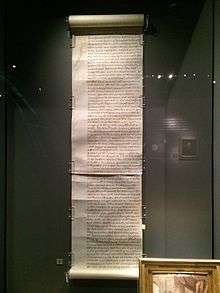Longitude Act
The Longitude Act 1714 was an Act of Parliament of the United Kingdom passed in July 1714 at the end of the reign of Queen Anne. It established the Board of Longitude and offered monetary rewards (Longitude rewards) for anyone who could find a simple and practical method for the precise determination of a ship's longitude. The Act of 1714 was followed by a series of other Longitude Acts that revised or replaced the original.[1]
| Act of Parliament | |
.svg.png) | |
| Long title | An Act for Providing a Publick Reward for such Person or Persons as shall Discover the Longitude at Sea |
|---|---|
| Citation | 13 Ann. C 14 |
| Dates | |
| Repealed | 1828 |
Status: Repealed | |
| Text of statute as originally enacted | |
Background

As transoceanic travel grew in significance, so did the importance of accurate and reliable navigation at sea. Scientists and navigators had been working on the problem of measuring longitude for a long time. While determining latitude was relatively easy,[2] early ocean navigators had to rely on dead reckoning to find longitude. This was particularly inaccurate on long voyages without sight of land and could sometimes lead to tragedy, as during the Scilly naval disaster of 1707 which claimed the lives of nearly 2,000[3] sailors. This brought the problem of measuring longitude at sea into sharp focus once more. Following the Merchants and Seamen Petition, which called for finding an adequate solution and was presented to Westminster Palace in May 1714, the Longitude Act was passed in July 1714.
For details on many of the efforts towards determining the longitude, see History of longitude.
The rewards
The Longitude Act offered a series of rewards, rather than a single prize. The rewards increased with the accuracy achieved: £10,000 (worth over £1.46 million in 2019[4]) for anyone who could find a practical way of determining longitude at sea with an error of not greater than one degree of longitude (equates to 60 nautical miles (110 km; 69 mi) at the equator). The reward was to be increased to £15,000 if the error was not greater than 40 minutes, and further enhanced to £20,000 if it was not greater than half a degree.[5] Other rewards were on offer for those who presented methods that worked within 80 geographical miles of the coast (being the most treacherous part of voyages) and for those with promising ideas who needed help to bring them to readiness for trial. Many rewards were paid out over the 114 years of the Board of Longitude's existence.[1] John Harrison received more money than any other individual, with several rewards from the 1730s-1750s, and £10,000 in 1765.
Subsequent Longitude Acts offered different rewards. That of 1767 held out £5,000 for improvements to Tobias Mayer's lunar tables and that of 1774 halved the amount offered for any method or instrument achieving the degrees of precision outlined in the original Act (i.e. £5,000 for a degree, £7,500 for 2/3 of a degree or £10,000 for 1/2 degree). The 1818 Longitude Act, which completely revised the composition and remit of the Board of Longitude, again changed the rewards, by now offered for improvements to navigation in general rather than simply for finding longitude. In addition, the Act outlined rewards for navigating the North West Passage, again on a sliding scale from £20,000 for reaching the Pacific through a north west passage to £5,000 for reaching 110 degrees west or 89 degrees north and £1000 for reaching 83 degrees north. In 1820 £5,000 was paid to the officers and crews of HMS Hecla and HMS Griper under this Act.[1]
References
- Howse, Derek (1998). "Britain's Board of Longitude: The Finances, 1714–1828" (PDF). The Mariner's Mirror. pp. 400–417. Archived from the original (PDF) on 23 May 2014. Retrieved 14 July 2020. Cite magazine requires
|magazine=(help) - During daylight hours, latitude can be found from the altitude of the sun at noon with the aid of a table giving the sun's declination for the day. At night, latitude can also be determined altitudes of stars with known declination crossing the meridian (including Polaris, the northern pole star).
- Sobel, Dava, Longitude: The True Story of a Lone Genius Who Solved the Greatest Scientific Problem of His Time, Fourth Estate Ltd., London 1998, p. 6, ISBN 1-85702-571-7
- UK Retail Price Index inflation figures are based on data from Clark, Gregory (2017). "The Annual RPI and Average Earnings for Britain, 1209 to Present (New Series)". MeasuringWorth. Retrieved 2 February 2020.
- Longitude Act 1714
Further reading
- Alexi Baker (July 2013), Longitude Acts, Board of Longitude project, University of Cambridge Digital Library
- Image of the original act from the Parliamentary Archives